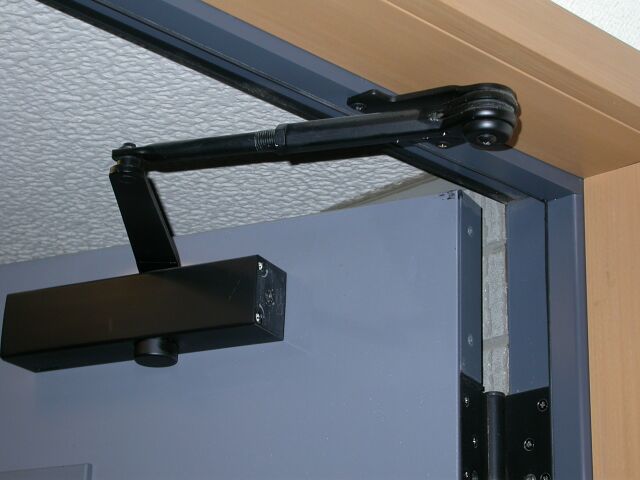Door closer
A door closer is a hydraulic device that is used to automatically close a door after it has been opened. Door closers are commonly used as a fire prevention measure, typically installed on fire doors, as well as helping to prevent draughts.
The most common types of door closer include:
Surface-mounted door closers are the most common type, as they are comparatively cost-effective and easy to install. They are fitted to the door frame behind the door, next to the hinge. The arm of the closer retracts to closed configuration as the door closes.
As well as the standard, double-lever arm, there are different kinds of arms available for surface-mounted door closers, depending on the application and to provide more functionality. These include:
- Hold open arm: By opening the door to a certain degree, a nut is tightened which causes the arm to stick at an open point.
- Dedicated parallel arm: In the closed position it lays parallel with the door instead of projecting outwards, although lacks the strength of the standard arm.
- Stop arm: Prevents the door from opening too far and hitting a wall or other obstacle.
Concealed door closers are hidden within the door jamb and are often used when aesthetics of the door is an important factor. This type fits in the morticed recesses in the door and the frame, allowing it to be completely concealed when the door is closed. This type is typically used for ‘double-acting’ doors, i.e. those that swing both ways; usually in high-traffic applications such as a busy office building door.
Floor closers are similar in that they are concealed within the floor and are not visible when the door is opened. Fitted into the underside of the door is a bar which controls the closing action, usually with an open setting that allows them to be left open. They are typically used with pivot hinges rather than butt hinges, which are stronger and more durable, and can often be found on glass front doors of commercial buildings.
[edit] Related articles on Designing Buildings Wiki
Featured articles and news
Government consultations for the summer of 2025
A year of Labour, past and present consultations on the environment, the built environment, training and tax.
CMA competitiveness probe of major housing developers
100 million affordable housing contributions committed with further consultation published.
Homes England supports Greencore Homes
42 new build affordable sustainable homes in Oxfordshire.
Zero carbon social housing: unlocking brownfield potential
Seven ZEDpod strategies for brownfield housing success.
CIOB report; a blueprint for SDGs and the built environment
Pairing the Sustainable Development Goals with projects.
Types, tests, standards and fires relating to external cladding
Brief descriptions with an extensive list of fires for review.
Latest Build UK Building Safety Regime explainer published
Key elements in one short, now updated document.
UKGBC launch the UK Climate Resilience Roadmap
First guidance of its kind on direct climate impacts for the built environment and how it can adapt.
CLC Health, Safety and Wellbeing Strategy 2025
Launched by the Minister for Industry to look at fatalities on site, improving mental health and other issues.
One of the most impressive Victorian architects. Book review.
Common Assessment Standard now with building safety
New CAS update now includes mandatory building safety questions.
RTPI leader to become new CIOB Chief Executive Officer
Dr Victoria Hills MRTPI, FICE to take over after Caroline Gumble’s departure.
Social and affordable housing, a long term plan for delivery
The “Delivering a Decade of Renewal for Social and Affordable Housing” strategy sets out future path.
A change to adoptive architecture
Effects of global weather warming on architectural detailing, material choice and human interaction.
The proposed publicly owned and backed subsidiary of Homes England, to facilitate new homes.
How big is the problem and what can we do to mitigate the effects?
Overheating guidance and tools for building designers
A number of cool guides to help with the heat.
The UK's Modern Industrial Strategy: A 10 year plan
Previous consultation criticism, current key elements and general support with some persisting reservations.
Building Safety Regulator reforms
New roles, new staff and a new fast track service pave the way for a single construction regulator.

























